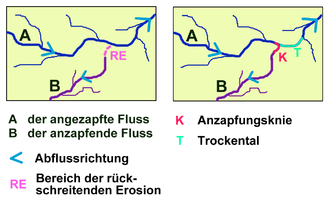Flux tapping
A river tap occurs when a river course shifts to another and this (in the literal sense) "digs the water off". The watershed is broken through and shifted: the tapped river withers below the tapping point, a dry valley can develop there, while the other increases its water volume with the external water.
An unusually strong bend in the river can be interpreted as an indication of such a process - it is called a tapping knee .
Tap and distraction
Only relatively sudden events are seen as tapping in the strict sense; longer-term geodynamic processes and their hydrographic effects are summarized in modern literature under the term river deflection . In fact, the "suddenness" in geological periods should always be viewed with caution and usually includes several intermediate stages.
causes
Several causes can be determined for the river tapping, which can represent interrelated processes in the geological development that have led to today's rivers:
- Tectonic uplift or subsidence: For example, an area is lifted in such a way that the river can no longer overcome it.
- Gravel : As a result of reduced flow speed or meandering , so much gravel is deposited in the river bed that it is lifted and finally a previously insurmountable obstacle (watershed) can be overflowed (see e.g. Feldbergdonau ).
- Retreating erosion : Due to the removal of material, the river cuts into the subsoil towards its source, which in special cases can lead to river tapping and a trunk pass.
- Glacier accumulation : This mostly creates glacier reservoirs that break out over an elevation and establish their new breakthrough valley before they recede again through retreating glaciers.
- Karst infiltration : tapping in the source horizon . In the underground water seeps into a foreign source area.
- Bog seepage : Real bifurcations can develop in large, flat river swamps and floodplains that are not in an orographic depression . Tectonic or erosive forces can later form real taps from them.
A “modern” form occurs in hydropower plant construction , where water from a catchment area is tapped into a distant power house. A drying out of the river can only be counteracted by adding residual water. In power plant construction, this is anchored in law or contract; where it is absent (major projects outside the industrialized nations), large-scale hydrological changes can occur.
Examples
- Wutach diversion of the Urdonau ( Feldbergdonau ) in the Wutach Gorge , whose tapping character is not certain
- The sinking of the Danube near Tuttlingen , where water is tapped underground into the Aachtopf to the Rhine
- Some breakdown in Friedberg -Ottmaring where the originally parallel to Lech extending few bends to the northeast, and the Lech leaves
- Infiltration of the Hönne in the Sauerland
- Donknie and Wolgaknie near Volgograd by uplifting the Volga threshold and the Jergeni hill relative to the Caspian Depression , today bridged by the Volga-Don Canal
literature
- Joachim Mangelsdorf, Karl Scheurmann: River morphology. A guide for scientists and engineers. Oldenbourg, 1980, ISBN 3-486-23311-4
